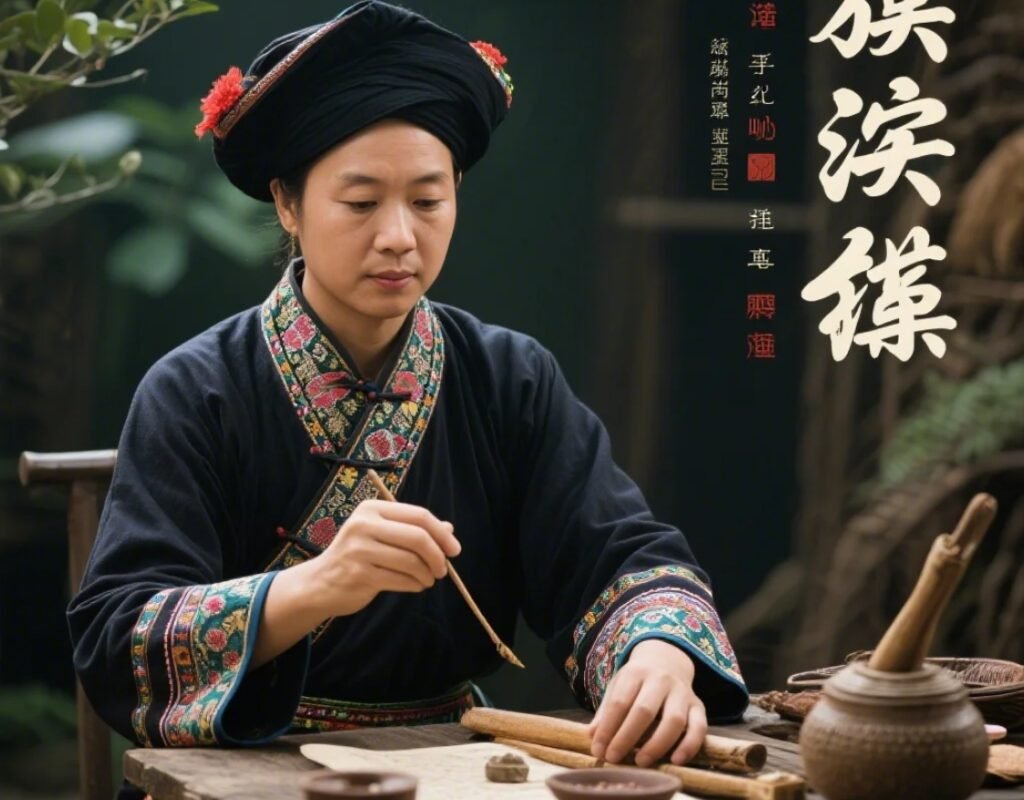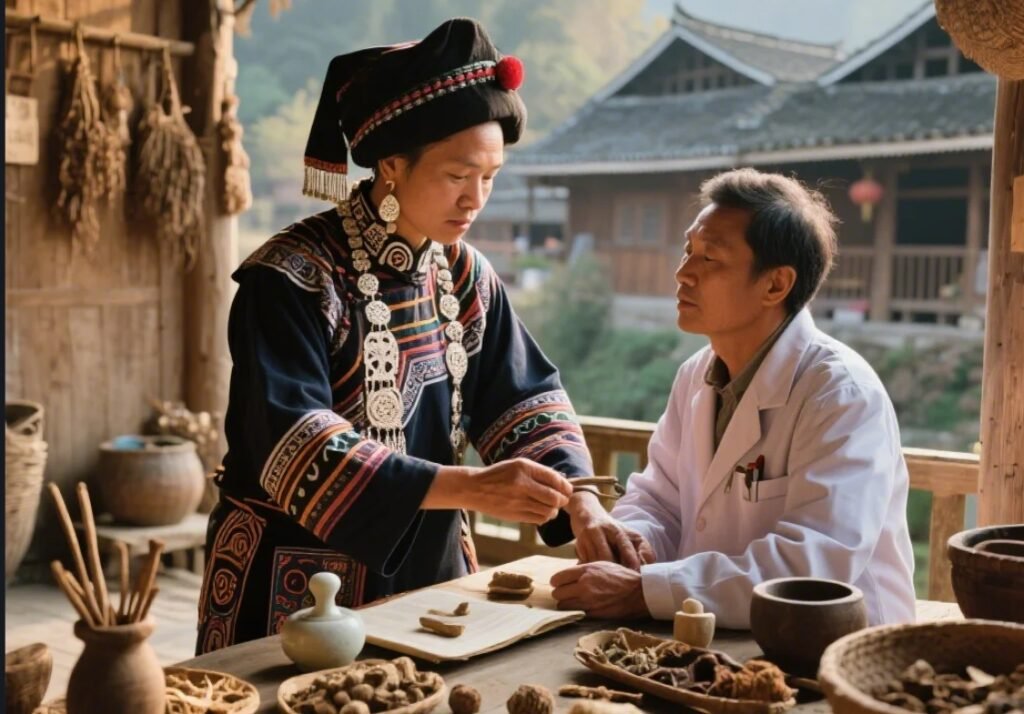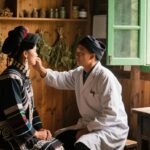An E A Luo You (Dyspnea Syndrome)
Overview
In Miao medicine, dyspnea syndrome is referred to as An E A Luo You. The causes of this condition are diverse and complex, involving cold-related illnesses, phlegm-dampness, qi deficiency, and blood deficiency. It often results from the invasion of external pathogenic factors (wind, cold, dampness, heat), overexertion, or exhaustion of qi and blood, leading to labored and short breathing.
Pathologically, dyspnea may present in excess or deficiency patterns. The excess type includes cold-induced dyspnea and phlegm-dampness dyspnea. Cold-induced dyspnea is treated with methods to open the Lung and relieve asthma, and warm the Stomach and disperse cold. Phlegm-dampness dyspnea is managed by dispersing the Lung, relieving cough, transforming phlegm, and calming dyspnea.
The deficiency type results from the depletion of qi and blood, impairing organ function and circulation over time. Miao medicine divides it into qi-deficient dyspnea and blood-deficient dyspnea. Treatment focuses on supporting the Lung to relieve asthma, while emphasizing qi and blood supplementation, strengthening the Spleen and Stomach, and nourishing the Liver and Kidney.
In Traditional Chinese Medicine (TCM), dyspnea is primarily characterized by labored breathing, open-mouth respiration, shoulder lifting during inhalation, flaring of the nostrils, and inability to lie flat. In severe cases, it may lead to collapse due to respiratory failure.
In modern medicine, dyspnea-related symptoms may appear in conditions such as pneumonia, asthmatic bronchitis, emphysema, pulmonary heart disease, cardiac asthma, or psychogenic dyspnea. This chapter can be referred to for syndrome differentiation and (used in traditional contexts) in such cases.

Hu Hou Ji Peng · Miao Medicine Symptoms
This syndrome is mainly manifested by shortness of breath and difficulty breathing, accompanied by red eyes, dry mouth, and dark yellow urine. Classified as a major syndrome, it is divided into four minor types: qi-deficient dyspnea, blood-deficient dyspnea, cold-induced dyspnea, and phlegm-dampness dyspnea.
Gen Duo Meng · Etiology
The causes of this condition vary widely. It may be triggered by wind, cold, dampness, or heat invading a weakened body, or due to prolonged illness, overwork, or damage to qi and blood. Pathogens enter through the mouth and nose, first injuring the Lung, qi, and blood. Insufficient qi and blood leads to phlegm obstruction, sluggish blood flow, and stagnation of qi, which restricts respiration. This results in cyanosis of the face, wheezing, and coughing.
Key Diagnostic Points
1. Diagnostic Criteria
Typical symptoms include labored breathing, shortness of breath, open-mouth breathing, shoulder lifting, nostril flaring, inability to lie flat, or cyanotic lips.
Often induced by emotional stress, fatigue, or external pathogens.
Frequently has a history of chronic cough, asthma, or palpitations.
2. Relevant Examinations
Blood tests (CBC), procalcitonin, C-reactive protein, pulmonary function tests, and CT scans should be conducted. When necessary, perform sputum cultures and BNP (B-type natriuretic peptide) tests to help differentiate between pulmonary infection and cardiac insufficiency.
Differential Diagnosis
Feng Le Pu Meng · An Wo (Pulmonary Cough)
Both An E A Luo You and Feng Le Pu Meng · An Wo may manifest with dyspnea and labored breathing. However, An E A Luo You typically occurs during acute or chronic illness episodes and is dominated by breathing difficulty and inability to lie flat. Feng Le Pu Meng · An Wo usually stems from toxic wind, cold, or heat, which damage qi and blood, obstruct vessels, and block qi flow, leading to cough and dyspnea, with cough being the primary symptom. If prolonged and recurrent, it may evolve into dyspnea syndrome.
Syndrome Classification and Treatment
1. Qi-Deficient Dyspnea
Meng Li Duo (Symptoms):
Short, weak breath sounds, low and weak cough, thin phlegm, spontaneous sweating, aversion to wind.
Xing Leng (Meridian Association):
Cold meridian, cold pattern.
Jia He Meng (Treatment Principle):
Disperse the Lung and calm dyspnea (xie fu nai bo qu xin), supplement qi and blood (bu yi xiang).
Duo Xi Jia, Gang Ou (Prescription and Explanation):
Codonopsis root (dangshen) 15g
Poria (fuling) 15g
Aster root (ziyuan) 12g
Perilla leaf (zisuye) 12g
Yiduo Yun (yiduoyun) 15g
Decoction for oral administration.
2. Blood-Deficient Dyspnea
Meng Li Duo (Symptoms):
Cough, dyspnea, shallow breathing, cannot lie flat, heat sensation, thirst, thick yellow sputum, flushed face, sore throat, large pulse.
Xing Leng (Meridian Association):
Hot meridian, heat pattern.
Jia He Meng (Treatment Principle):
Tonify Liver and Kidney (bu gan shen), stop cough and calm dyspnea (dang gou dang jin).
Ou Duo Xi Jia, Wang Ou (Prescription and Explanation):

Ephedra (mahuang) 10g
Raw gypsum (shigao) 30g
Morus root bark (sangbaipi) 15g
Perilla leaf (zisuye) 10g
Decoction for oral administration.
3. Cold-Induced Dyspnea
Meng Li Duo (Symptoms):
Wheezing, chest fullness, white thin sputum, headache, nasal congestion, aversion to cold, chills or fever, absence of thirst.
Xing Leng (Meridian Association):
Cold meridian, cold pattern.
Jia He Meng (Treatment Principle):
Disperse the Lung and relieve asthma (xie fu nai bo qu jin), warm Lung and dispel cold (he qi zhang she).
Ou Duo Xi Jia, Gang Ou (Prescription and Explanation):
Ephedra (mahuang) 12g
Prepared pinellia (banxia) 10g
Aged tangerine peel (chenpi) 12g
Apricot kernel (xingren) 12g
Rabbit Ear Grass (tuercao) 15g
Decoction for oral administration.
4. Phlegm-Dampness Dyspnea
Meng Li Duo (Symptoms):
Wheezing, chest tightness, copious white sticky phlegm that is hard to expectorate, nausea, poor appetite, sticky mouth, absence of thirst.
Xing Leng (Meridian Association):
Cold meridian, cold pattern.
Jia He Meng (Treatment Principle):
Disperse the Lung and calm dyspnea (xie fu nai bo qu jin), relieve cough and asthma (dang gou dang).
Ou Duo Xi Jia, Gang Ou (Prescription and Explanation):
Aged tangerine peel (chenpi) 12g
Prepared pinellia (banxia) 12g
Poria (fuling) 15g
Perilla leaf (zisuye) 10g
Magnolia bark (houpo) 10g
Decoction for oral administration.
Preventive Care
Avoid wind and cold; abstain from smoking and alcohol. Diet should be light and avoid greasy, spicy, and rich foods.
Regulate emotions. For cases induced by emotional triggers, maintain emotional well-being and avoid negative stimuli.
Strengthen physical exercise to enhance immunity and reduce the likelihood of developing dyspnea.
During episodes, rest in bed or semi-reclining position, ensure oxygen supply, monitor symptoms, keep air fresh, avoid irritants, maintain warmth, and consume a nutritious and calming diet.
Commentary
Miao medicine views dyspnea as a disorder of difficult breathing, often requiring open-mouth respiration, shoulder lifting, nostril flaring, and inability to lie flat. Severe cases may progress to respiratory collapse. The disease originates from wind, cold, dampness, or heat invading the Lung via mouth or nose. Although the Lung is the main affected organ, the Liver, Stomach, and Kidney may also be involved.
Pathologically, it manifests as either excess or deficiency.
Excess types:
Cold-induced dyspnea: treated by dispersing Lung, relieving asthma, warming the Stomach, and dispelling cold.
Phlegm-dampness dyspnea: treated by relieving cough, transforming phlegm, and calming dyspnea.
Deficiency types:
Focus on supplementing qi and blood, strengthening the Spleen and Stomach, and nourishing the Liver and Kidney while supporting the Lung and relieving cough and asthma.


Leave a Reply